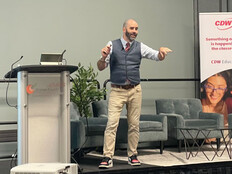ISTE 2019: How Superintendents Can Lead Digital Transformation
When former Vista Unified School District Superintendent Devin Vodicka sat down with students at Vista High School in California to hear how they would describe their school experience, he found there was a significant lack of engagement.
“I conducted 64 student seminars over six months,” Vodicka told attendees Monday at the International Society for Technology in Education’s 2019 annual conference in Philadelphia. “What we found was that one of the most common words students used was ‘irrelevant.’”
JOIN THE CONVERSATION: Follow @EdTech_K12 on Twitter for continued ISTE 2019 coverage.
According to Vodicka, Vista High School’s approach to education was stuck in an “industrial age,” in which students were taught to be “compliant factory workers in an assembly-line model.”
This system of education needed to change, through digital transformation, to move from “mass production to mass personalization” — to prepare students for a workforce that rewards creative problem solving.
“There are entire industries that are going through transformational change, and it’s not going to slow down,” Vodicka said.
Evaluate How Best to Reach and Utilize All Stakeholders
An important element of Vista’s digital transformation was to understand expectations and hesitations among community members, said Vodicka.
When working to get the transformation program off the ground, Vodicka found there were large knowledge gaps among parents, faculty and staff around what digital transformation and personalized learning really means.
To fix this, Vodicka hosted forums to answer questions, using analogies and concrete data to explain why the high school’s education program needed to change.
During these sessions, Vodicka was sure to shift away from how a transformation program would fix failing programs, instead highlighting what positive changes were possible.
“People aren’t inspired by a relentless deconstruction of underachievement,” said Vodicka. “focusing on problems can be a demotivating force.”
In addition to reaching faculty and staff, superintendents cannot ignore students’ voices.
When it comes to transformation initiatives, “we often neglect to get input from the most impacted,” said Vodicka. “If you are really serious about meaningful transformation, there is no better way to ensure your efforts are learner-centered than to engage learners, amplify their voices and give them agency to be a part of the improvement process.”
Aligning Program Goals and Resources Is Essential
One of the most important questions superintendents need to make sure their school faculty and staff can answer is what program goals are and how to achieve them, said Vodicka.
“It is critical that you are exceptionally clear and aligned on your vision, mission, values and goals,” he said. “As a superintendent, you won’t be available to answer every question. People need a North Star to guide them through the process.”
Vodicka worked with faculty, staff and students to come up with a framework for the future that outlined what it was that his school wanted to achieve over the next few years.
“Our No. 1 goal was to improve educational excellence and innovation,” said Vodicka. Through respect, trust and collaboration, he and his team strived to offer new opportunities for students to approach learning through real-world problem solving.
After identifying the vision, values and mission statement of their transformation program, Vodicka and his team created a list of nine markers they could use to measure success. These included improving proficiency in reading, writing and math; lowering absenteeism; and offering more opportunities for students to engage in technical education and service learning.
Identifying these strategic goals at the outset created unique funding opportunities for Vista. It was the specific metrics that came from these goals, said Vodicka, that secured the school a $10 million innovation grant from the XQ Superschool project in 2016.
For more of the latest stories out of ISTE 2019, check out our conference page here.










